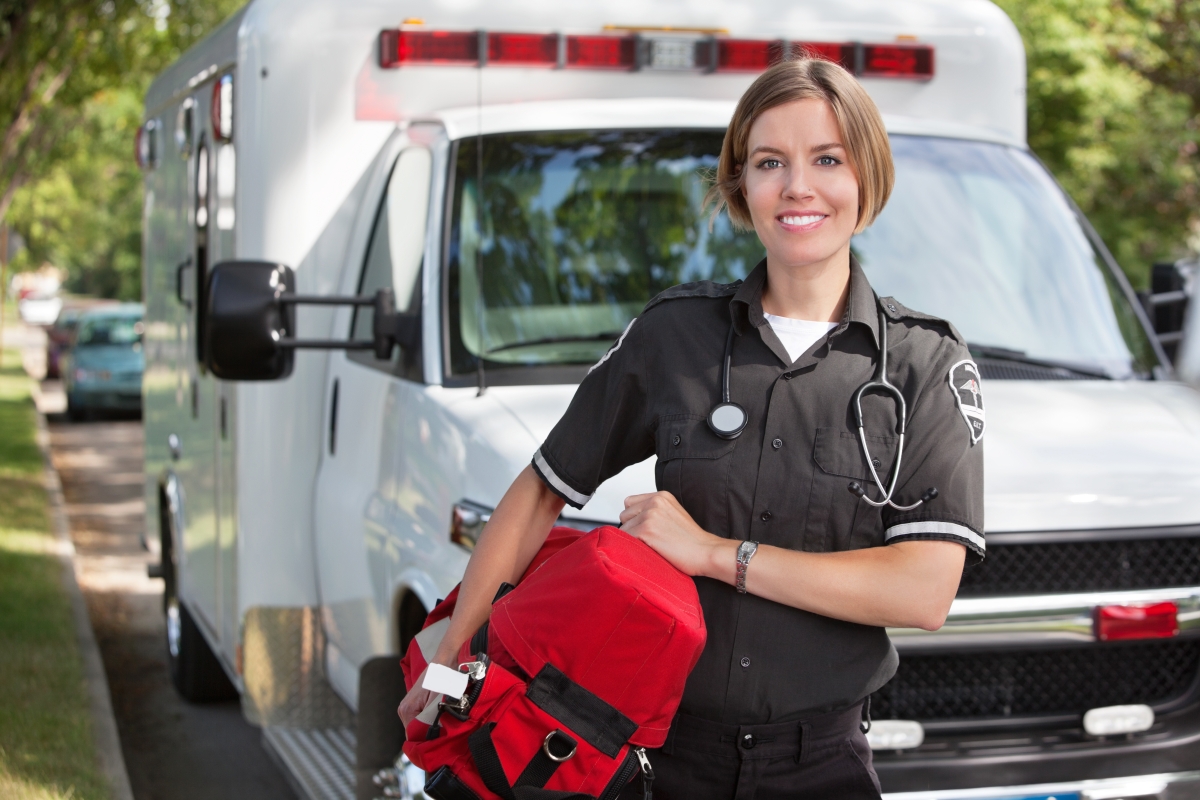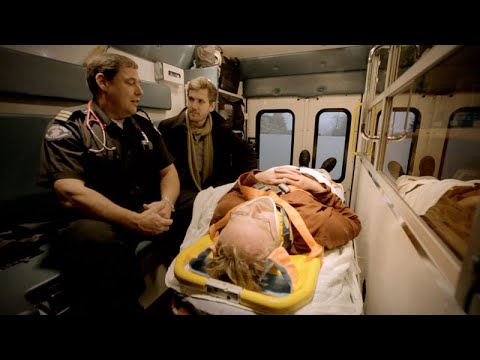Career Overview
This unit group includes workers who administer pre-hospital emergency medical care to patients with injuries or medical illnesses and transport them to hospitals or other medical facilities for further medical care. Paramedics who are supervisors are included in this unit group.
People in this occupation:
- Are part of B.C.'s system of emergency medical assistants (EMAs) who give pre-hospital emergency medical care to patients with injuries or medical illnesses
- Transport patients to hospitals or other medical facilities for further medical care
- Are in one of several levels of EMAs, from emergency medical responder (EMR) to critical care paramedic (CCP)
- Are primarily employed by the BC Ambulance Service, however, some work in industrial, hospital and other settings
- Are also employed by private ambulance services, hospitals, fire departments, government departments and agencies, manufacturing firms, industrial sites and other private sector establishments (i.e., first aid attendants and first responders)
- Should have excellent communication skills and have a strong desire to help people
- Must also be able to make decisions calmly and efficiently in moments of crisis and
- Must be able to work well independently and as part of a team
Job Titles
Duties
Workers in this group:
- Assess extent of injuries or medical illnesses of trauma victims, patients with respiratory disease and stress, overdose and poisoning victims, industrial accident victims and other ill or injured individuals to determine emergency medical treatment
- Administer pre-hospital emergency care to patients such as oxygen therapy, cardiopulmonary resuscitation (CPR), spinal immobilization, bandaging and splinting
- Establish and maintain intravenous treatment (IV), apply adjunctive equipment for ventilation and circulation complications, administer medications and provide other advanced emergency treatment to patients
- Transport patients by air, land or water to hospital or other medical facility for further medical care
- Collaborate with ambulance dispatch centres, hospital staff, police, firefighters and family members to ensure relevant information is collected and proper treatment is administered
- Document and record nature of injuries and illnesses and treatment provided
- Assist hospital personnel with provision of medical treatment, if necessary
- Maintain ambulances and emergency care equipment and supplies
- May train and supervise other workers in this unit group
- May assist with triage of emergency patients
Special duties
Emergency medical assistants have a higher and more specialized level of training than first aid attendants.
Earnings
Earnings is income that workers receive in exchange for their labour. Depending on the type of employment, earnings can be in the form of wages (hourly), salaries (fixed monthly or annual) or self-employed earnings.
Work Environment
# Workers Employed
3,605% Employed Full Time
60%Most emergency medical assistants in B.C. work for the BC Ambulance Service. Full-time paramedics work assigned shifts. Part-time paramedics work on call, depending on need, scheduling and availability. The BC Ambulance Service hires EMRs only on a part-time, on-call basis. Since services are provided 24 hours per day, weekend, evening and holiday work is required. Workers may also have to work some overtime.
Some emergency medical assistants work in hospitals and in industrial settings such as oilfields. These workers work assigned shifts and may have to work weekends and holidays.
Paramedics work both indoors and outdoors in a physically demanding job. Workers spend a great deal of time standing, kneeling, bending and lifting patients in stretchers.
For many first aid attendants, providing first aid is not their primary responsibility, but is combined with the other duties and responsibilities of their jobs. Therefore, this occupation is not always a full-time job. Those first aid attendants who work full-time in high-risk workplaces and those who drive industrial ambulances may also have to work weekends and holidays. Some full-time first aid attendants may work seasonally in industries that operate outdoors.
Workers in this occupational group may be exposed to contagious or potentially dangerous diseases, so precautionary measures are taken to reduce these risks.
While work can be physically demanding, as well as emotionally stressful, many find these occupations to be both challenging and rewarding.
Career Pathways
New graduates typically get positions as primary care paramedics in both industry and with the BC Ambulance Service. However, new roles are emerging for primary care paramedic graduates in B.C. as emergency room attendants in hospitals.
In Canada, the highest level of certification paramedics can pursue through advanced training is the critical care paramedic (CCP). Some paramedics may also choose careers in other emergency services or health-care fields by completing additional training.
With further training and considerable work experience, workers in this occupational group may be able to work as supervisors, operations managers or senior administrators. Other related careers include dispatcher, instructor and salesperson of emergency medical equipment.
First aid attendants with Occupational First Aid Level 3 qualification may take an Occupational First Aid to Emergency Medical Responder (OFA-EMR) bridging course to qualify to apply for EMR licensing in B.C. First aid attendants may also choose a career in occupational health and safety.
Occupational Interests
It’s important to understand what kinds of occupations align with your interests.
For more about occupational interests visit Skills for the Future Workforce > Characteristics.
Here are the top occupational interest(s) for this career profile:
Education, Training and Skills
Employment requirements for workers in this occupational group vary based on the occupation and the employer.
There are four different levels within the EMA occupation nationally, relating to the level of training a worker has completed:
- Emergency medical responder
- Primary care paramedic
- Advanced care paramedic
- Critical care paramedic
In B.C., there are five practitioner levels within the EMA occupation:
- Emergency medical responder
- Primary care paramedic
- Advanced care paramedic
- Critical care paramedic
- Infant transport team
Critical care paramedics and infant transport team paramedics are specialized teams within the BC Ambulance Service.
Emergency medical responder (EMR) requires an entry-level training program in emergency patient care and transportation. Primary care paramedic (PCP) requires a certificate program, including practicum. Advanced care paramedics (ACP) must complete a diploma program.
Critical care paramedic (CCP) is the highest level of paramedic certification within B.C.
The CCP program training in B.C. is only accessible to advanced care paramedics who currently work for BC Emergency Health Services (BCEHS).
There are currently six levels of Emergency Medical Assistant (EMA) licences in British Columbia; each licence level increases the services EMAs may provide. The exception to this is the infant transport team that builds on primary care paramedic services but not advanced care or critical care paramedic services.
All levels of EMAs are governed by the Emergency Medical Assistants Licensing Board. To be licensed in the province, graduates with certificates from a B.C. recognized training agency must complete the appropriate licensing examinations, which include a written exam, a jurisprudence exam, and a practical or oral exam.
Paramedics (PCPs and ACPs) and emergency medical responders (EMRs):
- Work for the BC Ambulance Service, which is the sole provider of pre-hospital emergency health care for the province
- Must have Grade 12 or equivalent, EMR licence or comparable qualification and CPR Level "C" certificate
- Who hold a minimum Primary Care Paramedic licence or equivalent are preferred applicants
Applicants for EMA positions of all levels:
- Must have a Class 1, 2 or 4 B.C. driver's licence and a Class 4 unrestricted licence is preferred
- Should also have a driving record that demonstrates safe and competent driving behaviour
- Must pass a physical abilities test and a comprehensive criminal records review
First aid attendants working in industrial or other settings:
- Must hold a valid certificate of Occupational First Aid (Level 1, 2 or 3) issued by WorkSafeBC (formerly the Workers' Compensation Board of BC) or the equivalent
Occupational first aid courses that are recognized by WorkSafeBC range in length from one day to 70 hours. They include a Transportation Endorsement for Level 1 and 2 Occupational First Aid attendants. Graduates must pass written, oral and practical examinations. WorkSafeBC recognizes an EMR licence as meeting Occupational First Aid Level 3 requirements in the workplace. However, Occupational First Aid Level 3 certification is not considered equivalent to any EMA license category.
See the Emergency Medical Assistants Licensing Board website for information on EMR and paramedic training.
For information on first aid attendant training, see the WorkSafeBC website at https://www.worksafebc.com/en/health-safety/education-training-certification/first-aid-attendant.
Those who are certified for an occupation by a regulator elsewhere in Canada can apply for the same certification from the regulator in B.C. Under the terms of the Canadian Free Trade Agreement (CFTA), most applicants who are transferring their credentials from elsewhere in Canada will not be required to complete additional training or testing. However, the B.C. regulator may ask applicants to provide further information such as a letter of good standing, references, or criminal record check.
For those who trained outside of Canada and never received certification from any Canadian jurisdiction, a full assessment is likely needed. Most occupational regulators have a process for assessment and recognize internationally trained applicants.
For details on how to apply for certification in B.C., contact WorkSafe BC and/or the Ministry of Health: Emergency Medical Assistants Licensing Board of BC.
For information about labour mobility in Canada, visit www.workersmobility.ca.
View a list of Professional Regulatory Authorities in B.C.
Education programs in B.C.

Top Skills
Every job calls for a certain set of skills. Knowing those skills is the first step in finding a good career fit.
Here, you will find the 10 most relevant workplace skills. Some are more important to achieving success in a certain career than others. These skills may come naturally to you or you may need to gain them through education, training and experience.
See the list of work-related skills below, ranked in order of importance for this career. Check out the list and see if this career matches your skills—take that first step!
Actively looking for ways to help people.
Using logic and reasoning to identify the strengths and weaknesses of alternative solutions, conclusions or approaches to problems.
Giving full attention to what other people are saying, taking time to understand the points being made, asking questions as appropriate, and not interrupting at inappropriate times.
Understanding written sentences and paragraphs in work-related documents.
Being aware of others’ reactions and understanding why they react as they do.
Understanding how new information could be used to solve current and future problems in making decisions.
Talking to others to share information effectively.
Teaching others how to do something.
Considering the relative costs and benefits of potential actions to choose the most appropriate one.
Keeping track of and assessing your performance, other individuals, or organizations to make improvements or take corrective action.
Labour Market Statistics
Discover data, facts and information that have been gathered and analyzed. Learn about the characteristics of the economy and labour market in B.C.
Employment
Find out about employment types and trends by region and industry.
Employment
3,605Employment by Region







| Region | Employment | % Employment of this Occupation |
|---|---|---|
| Cariboo | 175 | 4.9% |
| Kootenay | 215 | 6.0% |
| Mainland/Southwest | 1,485 | 41.2% |
| North Coast and Nechako | 150 | 4.2% |
| Northeast | 65 | 1.8% |
| Thompson-Okanagan | 595 | 16.5% |
| Vancouver Island/Coast | 920 | 25.5% |
Labour Market Outlook
The B.C. Labour Market Outlook is a 10-year forecast of the expected supply and demand for labour in the province. It’s usually updated every year. The purpose is to provide British Columbians with the knowledge to make informed decisions on careers, skills training, education and hiring.
Forecasted Job Openings (2025-2035)
1,910Forecasted Job Openings
Forecasted Employment Growth Rate
Composition of Job Openings
Job Openings by Region (2025-2035)







| Region | Job Openings | Avg. Annual Employment Growth |
|---|---|---|
| Cariboo | 80 | 2.2% |
| Kootenay | 150 | 2.2% |
| Mainland/Southwest | 810 | 2.2% |
| North Coast and Nechako | 80 | 2.2% |
| Northeast | 30 | 1.2% |
| Thompson-Okanagan | 310 | 2.0% |
| Vancouver Island/Coast | 450 | 2.3% |
Industry Highlights
Learn about the opportunities in B.C.'s major industries, including employment trends, earning potential, locations of work and more.
Forecasted Job Openings by Industry
| Industry | Job Openings (2025-2035) |
|---|---|
| Health Care and Social Assistance | 1,810 |
| Public Administration | 40 |
| Educational Services | 10 |
| Wholesale Trade | 10 |
| Professional, Scientific and Technical Services | 10 |
Insights from Industry
Most of the opportunities will come from the need to replace retiring workers.
The creation of new jobs for paramedics reflects the fact that B.C.'s population is both growing and aging, which is leading to greater demand for emergency medical services. Paramedics are now being used increasingly outside the traditional pre-hospital setting. Some provide care in hospitals and in industry settings.
There may be increased demand for advanced care level paramedics in hospital emergency room settings and for rural health-care teams because of their greater scope of practice.
The majority of first aid attendants provide first aid services as one aspect of their job. Industry sources indicate there are many qualified first aid attendants in the labour market and that getting a full-time position as a first aid attendant is difficult. Those interested in working as first aid attendants must have other skills they can apply in an office or on a job site in addition to first aid skills.
Resources
-
BC Emergency Health Services – Careerswww.bcehs.ca/careers
-
BC Emergency Health Services (BCEHS)www.bcehs.ca
-
British Columbia Health Authoritieswww2.gov.bc.ca/gov/content/health/about-bc-s-health-care-system/partners/health-authorities
-
Fraser Healthwww.fraserhealth.ca/
-
Health Match BCwww.healthmatchbc.org/
-
Interior Health – Jobsjobs.interiorhealth.ca/
-
Island Healthwww.islandhealth.ca/
-
Northern Health – Careerscareers.northernhealth.ca/
-
Paramedic Association of Canadawww.paramedic.ca
-
Provincial Health Services Authority (PHSA) – Jobsjobs.phsa.ca/
-
Vancouver Coastal Health (VCH)www.vch.ca/








